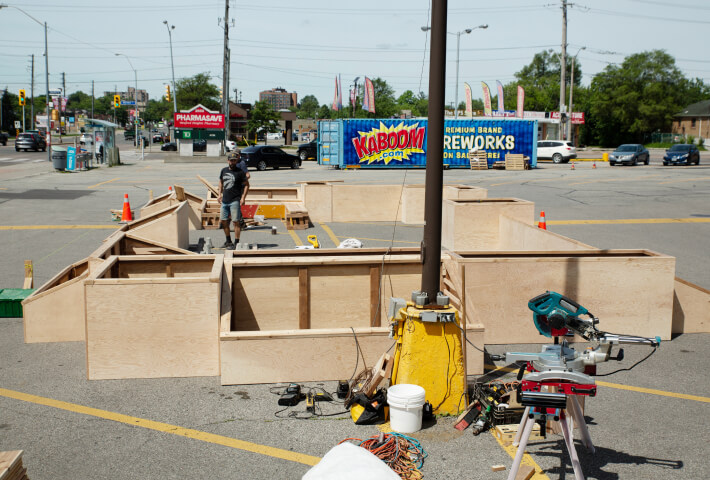2019: WexPOPS
When parks pop-up, butterflies pop in

By Jake Tobin Garrett
When parks pop-up, butterflies pop in
The coolest thing happened in the middle of a Toronto strip mall parking lot along Lawrence West in Scarborough last month: a monarch butterfly came to visit.
No, it wasn’t looking for lunch at The Wexford Restaurant (though I hear it’s good)–the butterfly was attracted by over 360 native pollinator plants that were part of a pop-up park installation called WexPOPS.
WexPOPS, led by artist and Master of Landscape Architecture graduate Daniel Rotsztain and University of Guelph professor Brendan Stewart, was intended as a project to support community-use and social gathering. It was one of five projects funded through Park People’s Public Space Incubator program in 2018.
When parks pop-up, butterflies pop in
But the design also included lots of native plants, supplied by Native Plants in Claremont, thanks to the collaborative design process between local community members and University of Guelph landscape architecture students.
“We selected a wide variety of native perennial wildflowers and meadow grasses — 29 species in all — and we certainly hoped to attract bees and butterflies and other insects, but we’ve been completely amazed at the results,” Brendan Stewart said.
“It’s been quite dramatic to watch the monarch’s progress from larva to adult butterflies, and to see how much milkweed they eat in the process. The garden is constantly buzzing and visitors tend to be surprised and delighted to experience this much life in the middle of a huge parking lot.”
It’s a striking example of how small pin-pricks of nature in an otherwise sea of pavement — even in temporary spaces — can help support biodiversity and threatened species, like pollinators.
Emerging research backs this up, too. A recent study explored the potential of temporary pop-up parks (cutely acronymed PUPS) to support greater species diversity.
When parks pop-up, butterflies pop in
Large scale green spaces are critical, but the study author points to research showing that the quality and density of ground-level plants — like the native plants populating WexPOPS — can have a greater degree of influence on species diversity than factors in larger green When parks pop-up, butterflies pop in
spaces, like tree density.
The conclusion: don’t discount the importance of small spaces.
This should come as welcome news to Canadian cities who are hard at work trying to restore natural habitat lost to urbanization and increase biodiversity. Supporting biodiversity was a key trend we found in our 2019 Canadian City Parks Report–which surveyed 23 cities–released in June.

In particular, Toronto is doing some creative work with a newly approved Pollinator Strategy. The City just launched its first PollinateTO community grants, which fund small-scale pollinator gardens cultivated by local residents. As WexPOPS shows, these initiatives can have quite positive impacts, when using the right native plant mixtures for local species.
Vancouver is also working to create small pollinator gardens in the city. A pop-up pollinator park planted at 5th and Vine in 2016 on a small 0.3 acre site packed in 1,500 community- planted pollinator plants. A citizen science survey observed the second highest number of pollinator species within the garden compared to other observed park sites.
Red Deer has designated four official pollinator parks where city staff handpick weeds and pesticide use is banned. And Hamilton’s Pipeline Trail features small pollinator gardens along its route tended by local community members.
You can read more about how cities across Canada are supporting pollinators and urban biodiversity by reading about it in our Canadian City Parks Report.
Back in Scarborough, the team behind WexPOPS will be taking down the pop-up near the end of August, meaning the parking spaces it occupies will go back to housing cars rather than plants and people.
A critical question in thinking about the viability and importance of pop-up parks in contributing to urban biodiversity is what happens after the pop-up pops down?
When parks pop-up, butterflies pop in
For the team behind WexPOPS that question was something they thought of from the very beginning. The plants will be transported to a local hydro corridor, which is undergoing its own transformation as a 16km linear park and trail called The Meadoway, where they will be re-planted.
This is a great solution, but there’s also an opportunity here to think about how these pop- up park projects can literally seed change in their own location.
For example, the plants repurposed within the stripmall parking lot itself. It’s these hardscape urban landscapes that require the most attention and care if we are to truly re- green our city, restoring some of the natural habitat we stole when we paved it over.
Some may look at micro-gardens like WexPOPS sitting in the middle of a parking lot and wonder: what good is this actually doing?
But as WexPOPS shows, if you build it butterflies will come.



